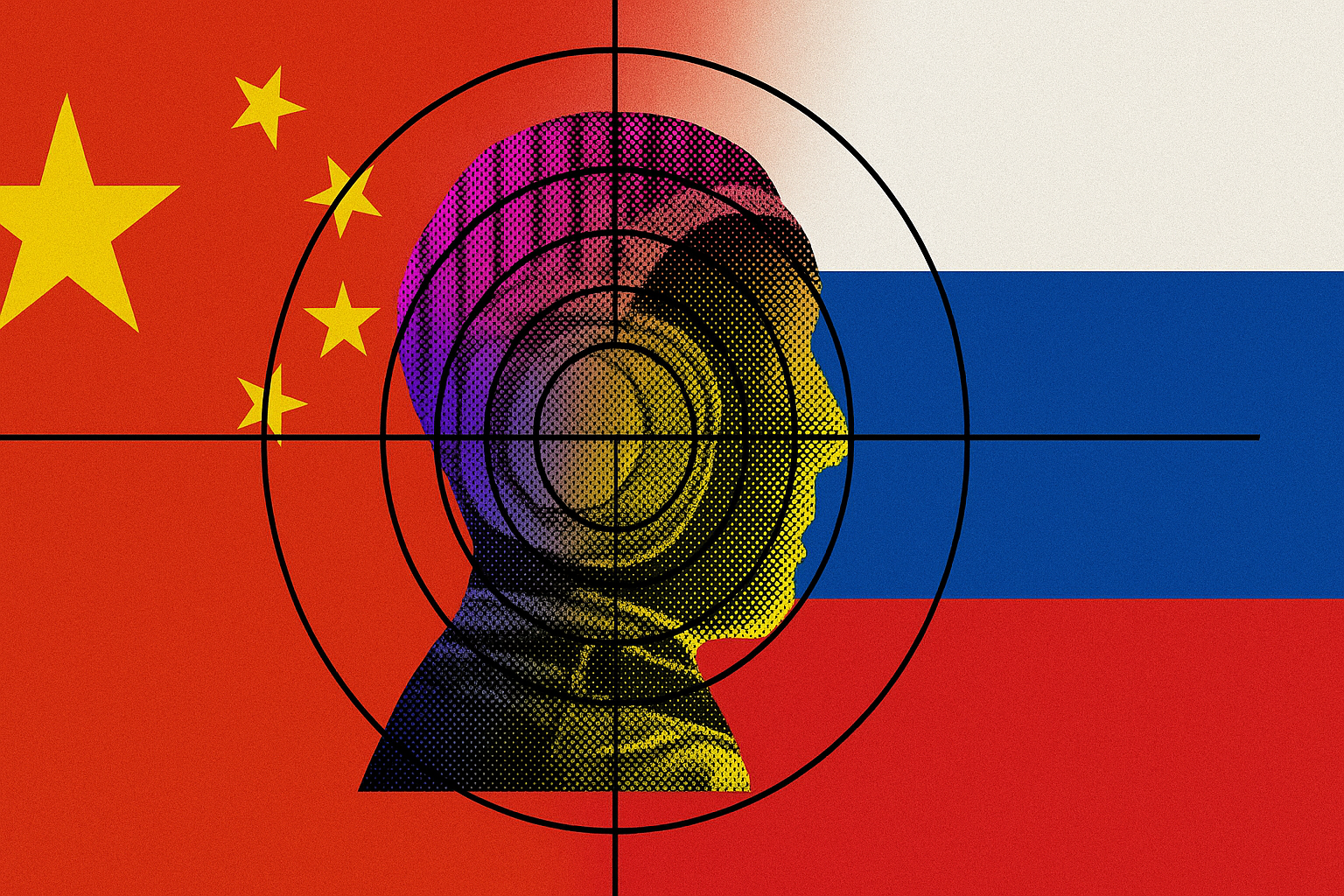
The official line says there’s “no clear evidence of a weapon.” Our reporting—and the science—point elsewhere. This installment follows the trail to the only two nations with the capability, history, and motive to weaponize invisible energy.
At Whale Hunting, we don't just report a story once—we keep going. Our "expeditions" are long-term investigations into topics and stories we think are important. One of those is Havana Syndrome. You may have heard the official verdict—"no clear evidence of a weapon," case likely closed. But behind the scenes, the story didn't stop. We are continuing to dig, and so are a lot of other people – victims, government officials, journalists. And the deeper we go, the more the scientific and intelligence communities quietly confirm what we suspected: this isn't over.
The stakes of identifying the perpetrator have never been higher. In September 2025, the House Intelligence Committee sent criminal referrals to the Department of Justice after uncovering 'alleged illegal activities' in the intelligence community's handling of Havana Syndrome cases, including claims that agencies withheld medical treatment from affected officers and obstructed congressional investigations.
That's why we relaunched our investigation publicly this summer—not as just a spy story, but as a forensic one. We're bringing fresh reporting, new interviews, and a systematic, evidence-first approach. We're mapping the data, breaking down the science, and examining the things hiding in plain sight.
Get the full story—free with your email.
This story is open to all and our work is available for free to anyone who signs up with their e-mail. But investigations like this aren’t cheap. If you believe accountability journalism matters, consider upgrading to a paid subscription—or sending a one-time boost. Every contribution directly funds more reporting like this.
Have a tip? Reach us at:
📩 whalehunting@projectbrazen.com
📧 projectbrazen@protonmail.com
🔒 Secure contact details here.
We protect our sources.
Join the investigation: If you have information about Havana Syndrome incidents, directed-energy weapons programs, or government responses, contact us at syndrome@projectbrazen.com.
Quick recap: In our first edition, we explored the scientific plausibility of a directed-energy weapon capable of causing Havana Syndrome—examining how pulsed microwave energy and the "Frey effect" could produce the phantom sounds and neurological symptoms reported by over 1,500 U.S. personnel across 96 countries. We concluded that while the physics makes such a weapon theoretically possible, the engineering challenges are formidable and no device has been captured or detected (that we know of).
➡️ Read the first edition of our Havana Syndrome investigation here.
In our second edition, we turned to the medical evidence itself. Through the devastating case of Mark Lenzi and his family in Guangzhou, China, we examined the hard neurological proof: volumetric MRI scans showing measurable brain damage, "immaculate concussions" with no physical impact, and a pattern of symptoms that couldn't be faked or imagined. We also exposed the U.S. government's systematic cover-up—from deliberately using faulty detection equipment to sending psychiatrists instead of doctors.
➡️ Continue with the second edition of our Havana Syndrome investigation here.
This week, we confront the question that haunts every victim, every investigator, every person following this story: Who could do this?
When you're hunting for the perpetrator of a global campaign of covert attacks using exotic directed-energy weapons, you start with a simple question: who could do this?
The answer is more limited than you might think.
Building a weapon capable of causing Havana Syndrome isn't like assembling a bomb from fertilizer and diesel fuel. It requires decades of research into microwave bioeffects, sophisticated pulsed power engineering, compact high-voltage systems, precision beam-forming antennas, and—perhaps most importantly—the operational tradecraft to deploy such a weapon covertly across multiple continents without getting caught. This isn't a technology you can download from the dark web or reverse-engineer from commercial equipment. It requires a sustained, state-level investment in directed-energy weapons research spanning generations.
So let's eliminate the impossible.
Not a non-state actor: No terrorist group, cartel, or billionaire likely has the infrastructure or expertise to clandestinely build such weapons, which stem from Cold War–era military research in microwave and pulsed-power physics.
Not most nation-states: Only a handful of advanced militaries—France, the UK, Israel—have explored directed-energy weapons, but none show evidence of long-term programs targeting humans or covert use.
Not the U.S. itself: Washington’s directed-energy projects target drones and missiles, not its own diplomats. The victims’ profiles and attack locations point clearly away from any domestic source (though many people still believe this is not just plausible, but likely – we disagree).
That leaves us with a very short list.
In fact, after reviewing decades of open-source research, patent filings, military publications, and intelligence assessments, only two nations on Earth have demonstrated the capability, the institutional commitment, and the operational history necessary to conduct these attacks:
Russia and China.
These aren't just suspects of convenience. Both nations have pursued microwave weapons development for seven decades, have operational systems deployed today and have documented research into the biological effects of microwave radiation on humans. They also have strategic motives to disrupt American intelligence operations.
“The Russians had done all this work earlier — they knew, they had experience,” former National Security Advisor John Bolton, who served under President Trump from 2018 to 2019, told Whale Hunting.
Bolton, who spoke with Whale Hunting before his October 16 indictment on charges of mishandling classified information, noted that the first incidents of Havana Syndrome occurred in Havana, “a place where the Russians would have a lot of flexibility to operate.” He added that reports of American officials being targeted in China “could indicate that China was trying to do the same thing.”
“I think it’s not just appropriate, but logical, to ask which adversaries of the United States might be behind this,” Bolton said.
China and Russia’s programs are remarkably different—different origins, different technical approaches, different operational philosophies. To understand who might be behind Havana Syndrome, we need to examine both.
“The Russians had done all this work earlier — they knew, they had experience,” former National Security Advisor John Bolton
If you were designing a directed-energy weapon from scratch today, you’d likely end up with something resembling China’s high-power microwave (HPM) program.
China’s approach combines technical sophistication with systematic, top-down development, driven by an obsession with achieving ever-higher power outputs. While Russia’s program grew out of Cold War espionage and biomedical experiments, China’s stemmed from its nuclear weapons research and a deliberate push to create “new concept weapons” capable of offsetting U.S. technological advantages.
In 1964, Beijing launched Project 640, a missile defense initiative that included Project 640-3, focused on laser weapons. Two decades later, the 863 Program elevated directed-energy weapons to a national priority—establishing expert groups to coordinate HPM research across military institutes, universities, and defense industries, laying the foundation for today’s advanced systems.
Key institutions emerged as centers of excellence:

By the 1990s, China had achieved significant technical milestones: development of relativistic backward-wave oscillators (BWOs), virtual cathode oscillators (vircators), and magnetically insulated transmission lines (MILOs)—all capable of producing megawatt to gigawatt-level microwave pulses.
By the mid-2010s, China began publicly showcasing operational high-power microwave (HPM) systems and intensifying efforts to make them smaller, more mobile, more reliable, and more powerful.
Researchers at the National University of Defense Technology (NUDT) in Changsha have been central to this progress. Reports describe experiments in which NUDT scientists developed a compact HPM device just 0.3 meters in length, capable of producing 1.24 gigawatts of microwave power. The design was first detailed in a 2012 paper titled “Experimental Demonstration of a Compact Highly Efficient Relativistic Magnetron with Directly Axial Radiation,” authored by Wei Li of NUDT’s College of Optoelectric Science and Engineering.
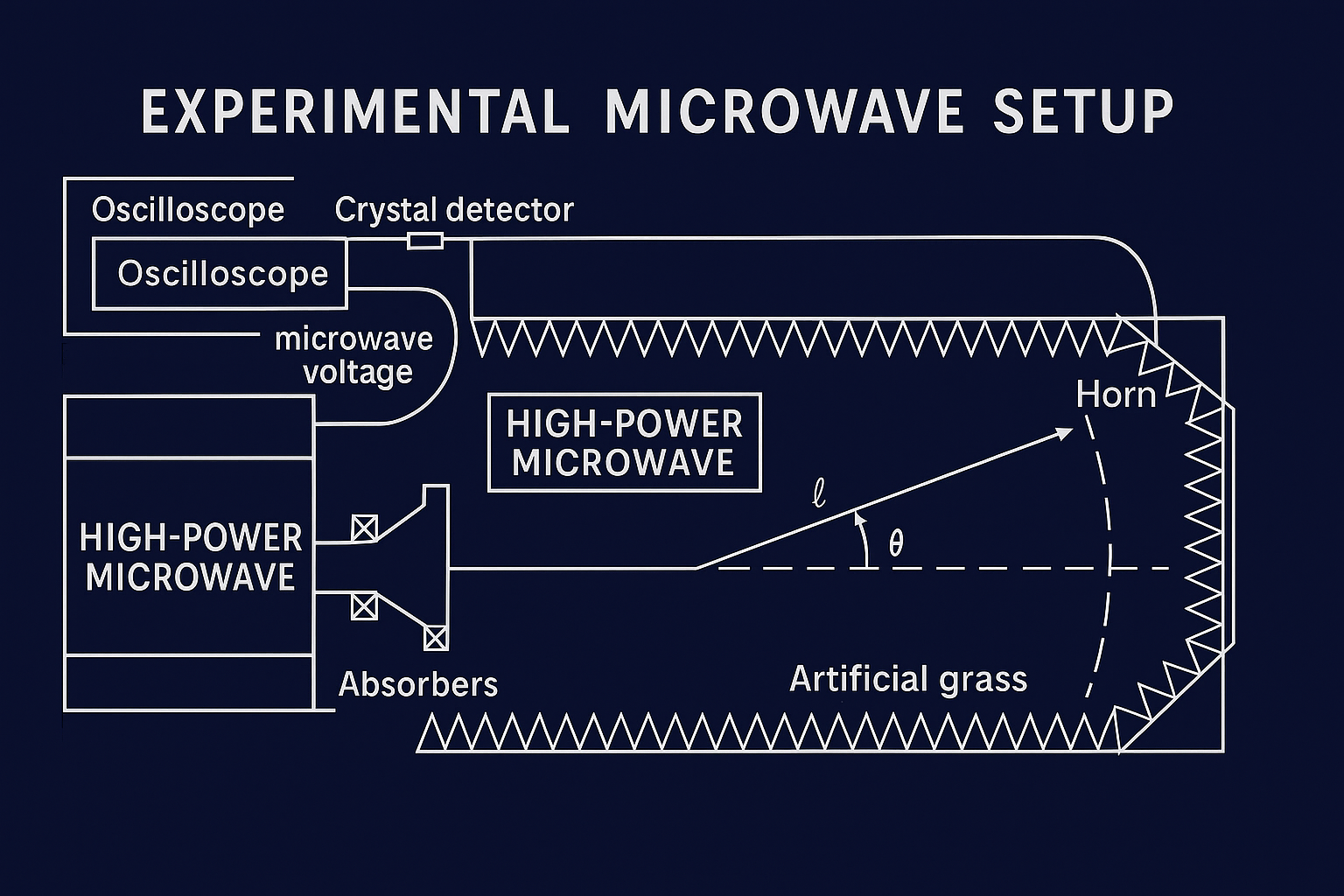
The study described a relativistic magnetron equipped with an antenna capable of emitting high-power, high-efficiency microwaves. Operating at 539 kV with a 0.38 T magnetic field, the device achieved an output of 1.24 GW—a staggering contrast to commercial TV or FM radio antennas, which emit frequencies between 80 and 800 MHz. The authors concluded that this configuration represented “the most compact, narrow-band, high-power microwave source” achieved to date.
In 2015, Wei Li and his team advanced the research with a new paper describing a Marx generator integrated with a pulse-forming line and a magnetron with diffraction output. The prototype, weighing 250 kilograms and measuring 120 centimeters, generated 2.32 GHz of microwave power with 38-nanosecond pulse durations.
A year later, in June 2016, Li published another study unveiling a dramatically miniaturized version—weighing just 50 kilograms yet maintaining the same 2.32 GHz output. The paper highlighted that “such a small size, light weight, and highly stable operation source will be used in portable repetitive high-power microwave generation systems,” signaling China’s ambitions to make field-deployable HPM weapons a reality.
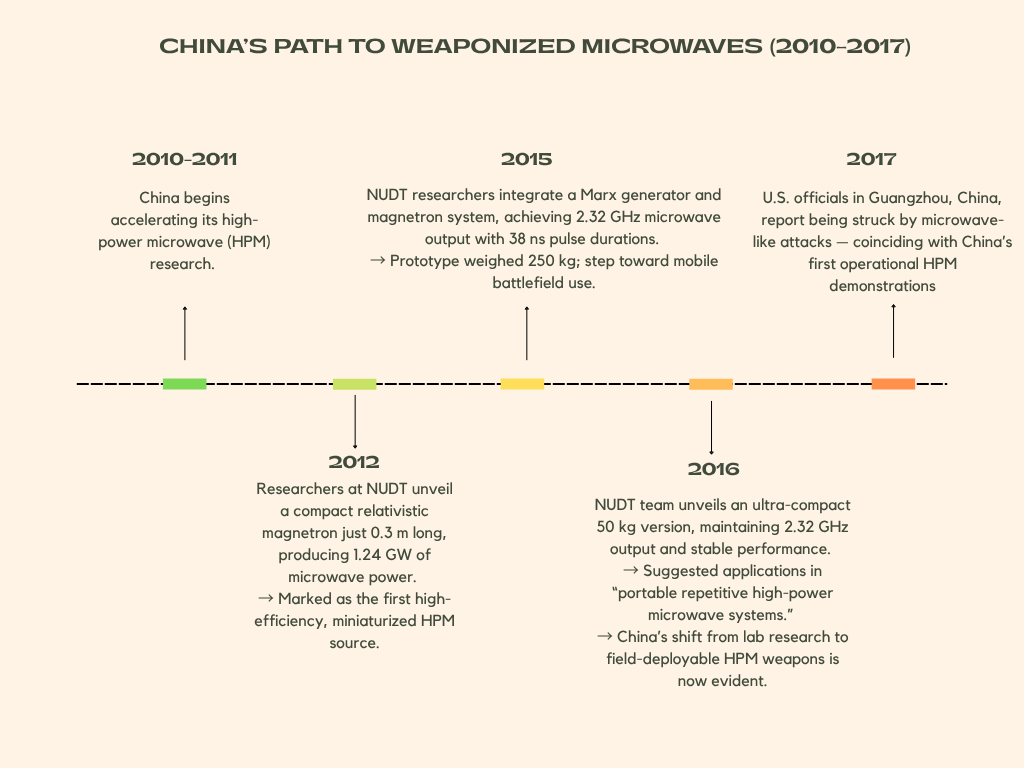
This year, China successfully conducted a live-fire test of a gigawatt-class high-power microwave anti-missile system called the Hurricane-3000. The system fired more than 5,000 full-power pulses to disable the electronics of an incoming missile target. This wasn't a laboratory curiosity. It was a key step in its production of a weapon system.

The Timeline Problem: China’s transition from laboratory research to operational HPM systems took place between 2010 and 2016—the same period when Havana Syndrome first emerged. The timing is striking, but correlation isn’t causation. The missing piece is motive: why would China risk exposure by targeting U.S. diplomats and intelligence officers?
The pattern of victims offers one clue. Many were involved in China-related intelligence work, and the Guangzhou incidents specifically hit State Department security staff with technical expertise. China’s doctrine of “unrestricted warfare” emphasizes preemptive disruption of adversary intelligence operations—potentially aligning with such behavior.
Yet the China theory has a flaw: tradecraft. Beijing’s HPM efforts have focused on military uses—anti-missile defense, counter-drone systems, and battlefield electronic warfare. There’s little evidence that Chinese intelligence has used covert directed-energy attacks abroad. The capability exists, but the operational pattern doesn’t quite fit.
That brings us to the other suspect, the one with not just the capability, but a documented history of doing exactly this before.
If China's microwave weapons program is characterized by technical sophistication and systematic development, Russia's is defined by something else entirely: operational experience targeting Americans with directed microwave energy.
Because Russia has done this before. For 23 years. Against the U.S. Embassy in Moscow. And they documented the medical effects.
In 1953, shortly after the U.S. Embassy in Moscow relocated to a new building on Novinsky Boulevard, American security personnel discovered something extraordinary during a routine sweep: the embassy was being bombarded with microwave radiation from a nearby Soviet apartment building.
Russia’s operation in Moscow was sophisticated and deliberate. A microwave beam operating at 2.5-4 GHz was continuously trained on the embassy building, with intensities of a few microwatts per square centimeter, for hours each day. The Soviets had "literally stuffed" the embassy with passive listening devices that were activated by the directed microwave beams—a pioneering application of wireless power transfer for espionage purposes.
Whale Hunting has reviewed over 1,200 declassified pages from the CIA and the U.S. State Department.
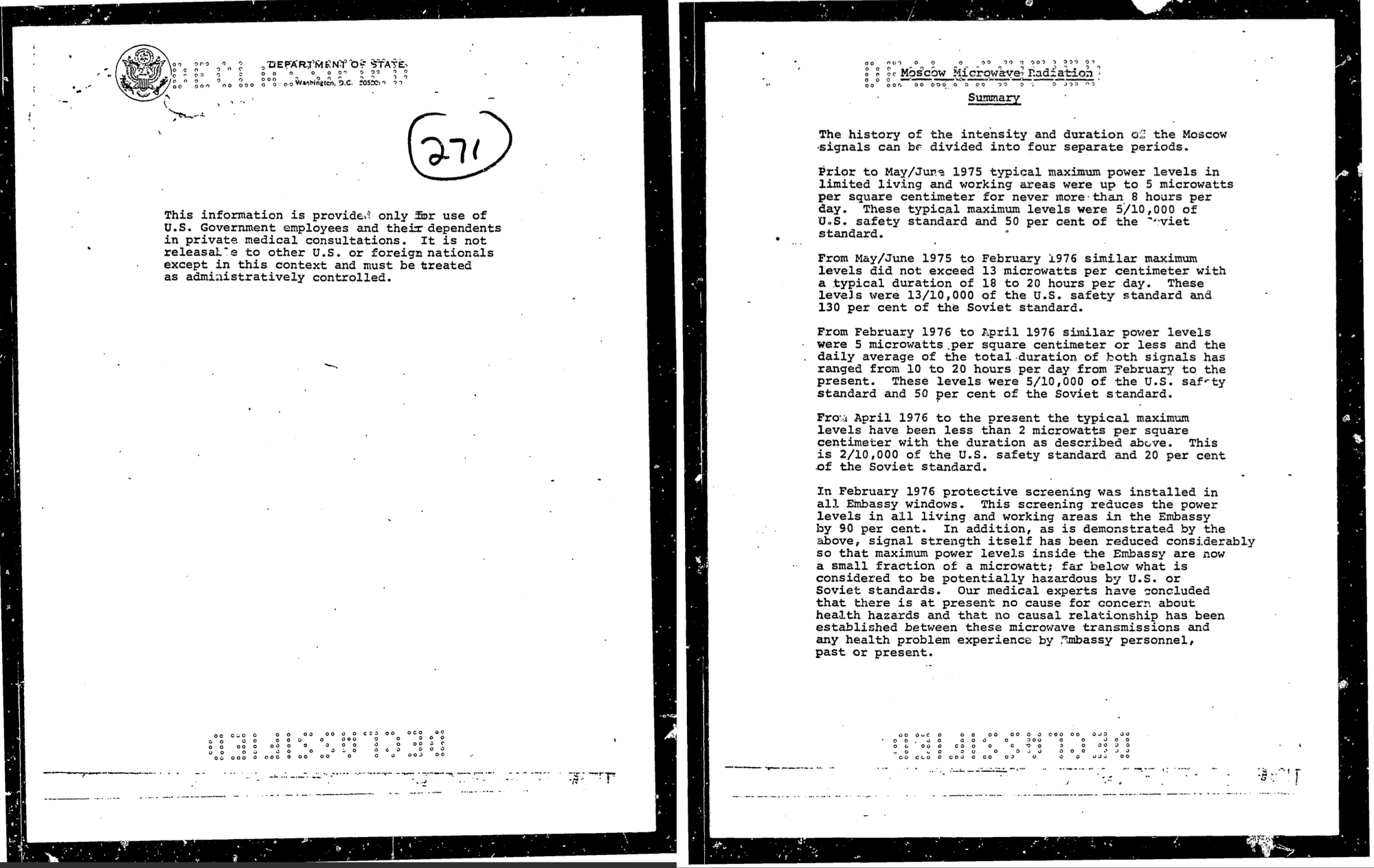
But here's what makes the Moscow Signal directly relevant to Havana Syndrome: the intensity was deliberately kept low, well below heating levels, and the fact of the irradiation was initially kept secret even from most embassy staff. The Soviets weren't trying to cook anyone. They were exposing American personnel to chronic, low-level microwave radiation while studying the effects.
By the late 1960s and 1970s, U.S. officials grew increasingly alarmed at potential health effects. American ambassadors—Foy Kohler, Llewellyn Thompson, Jacob Beam, and Walter Stoessel—repeatedly protested to the Soviet Foreign Ministry. Ambassador Stoessel's case was particularly troubling: he suffered nausea, eye bleeding, and ultimately developed leukemia.
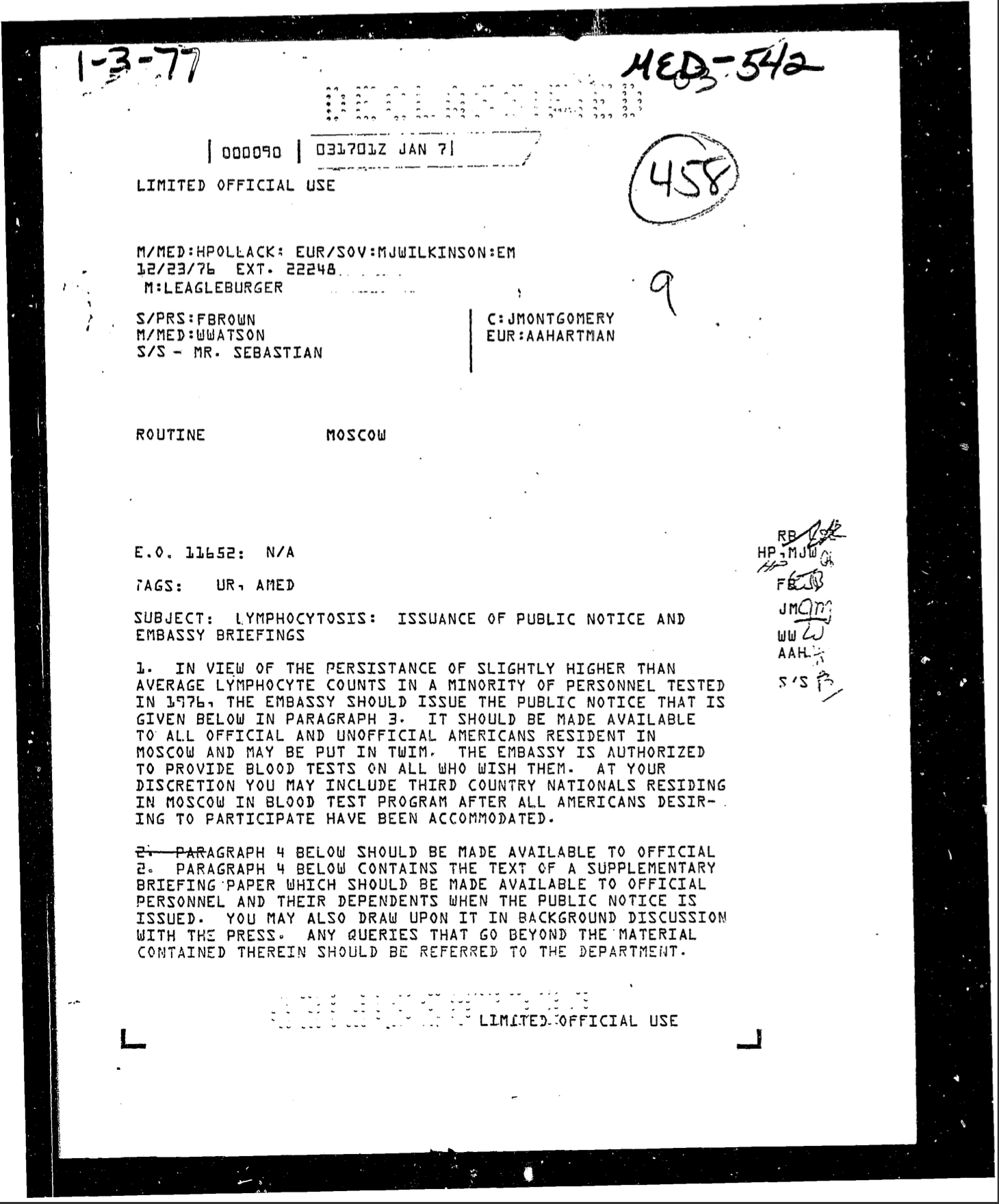
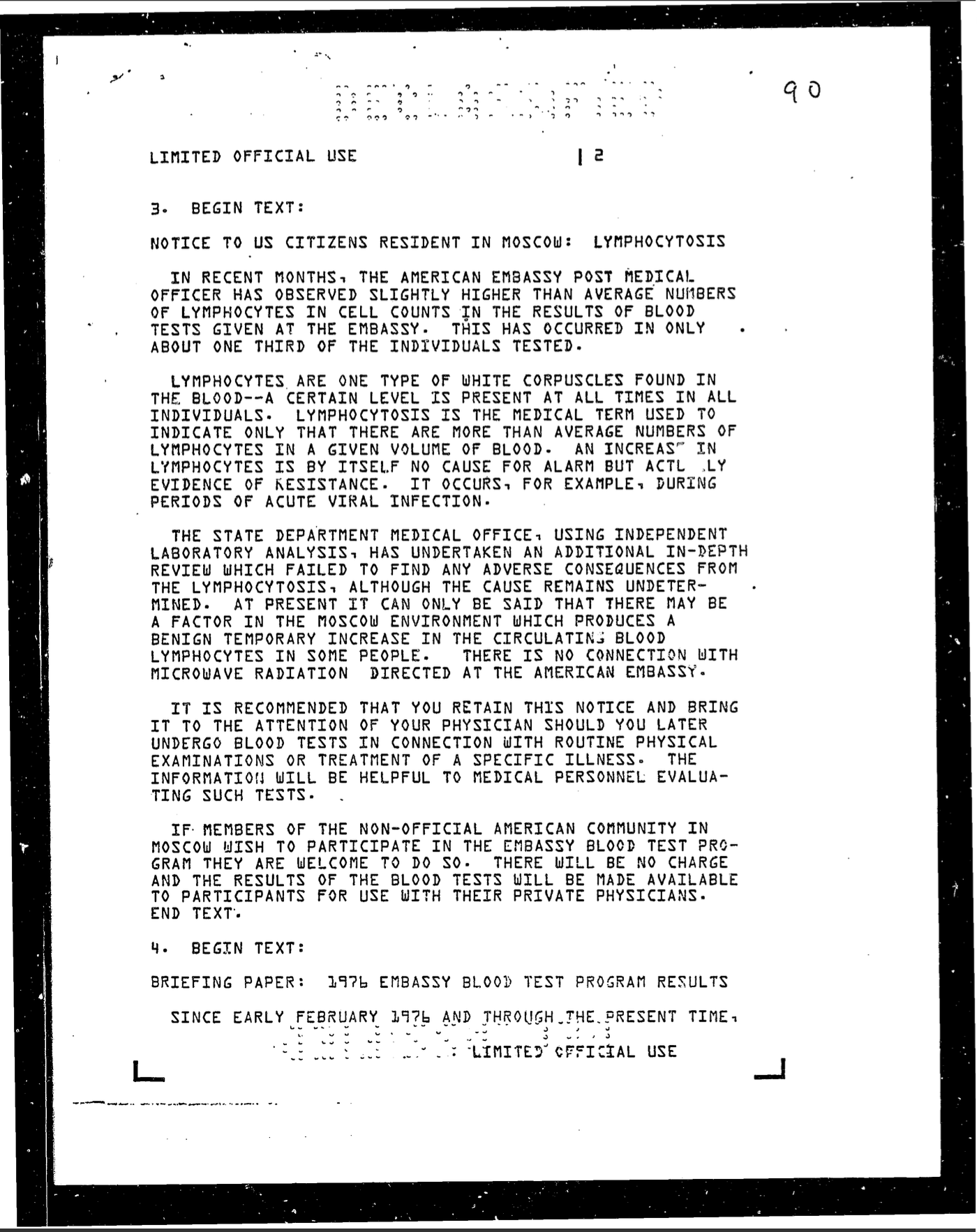
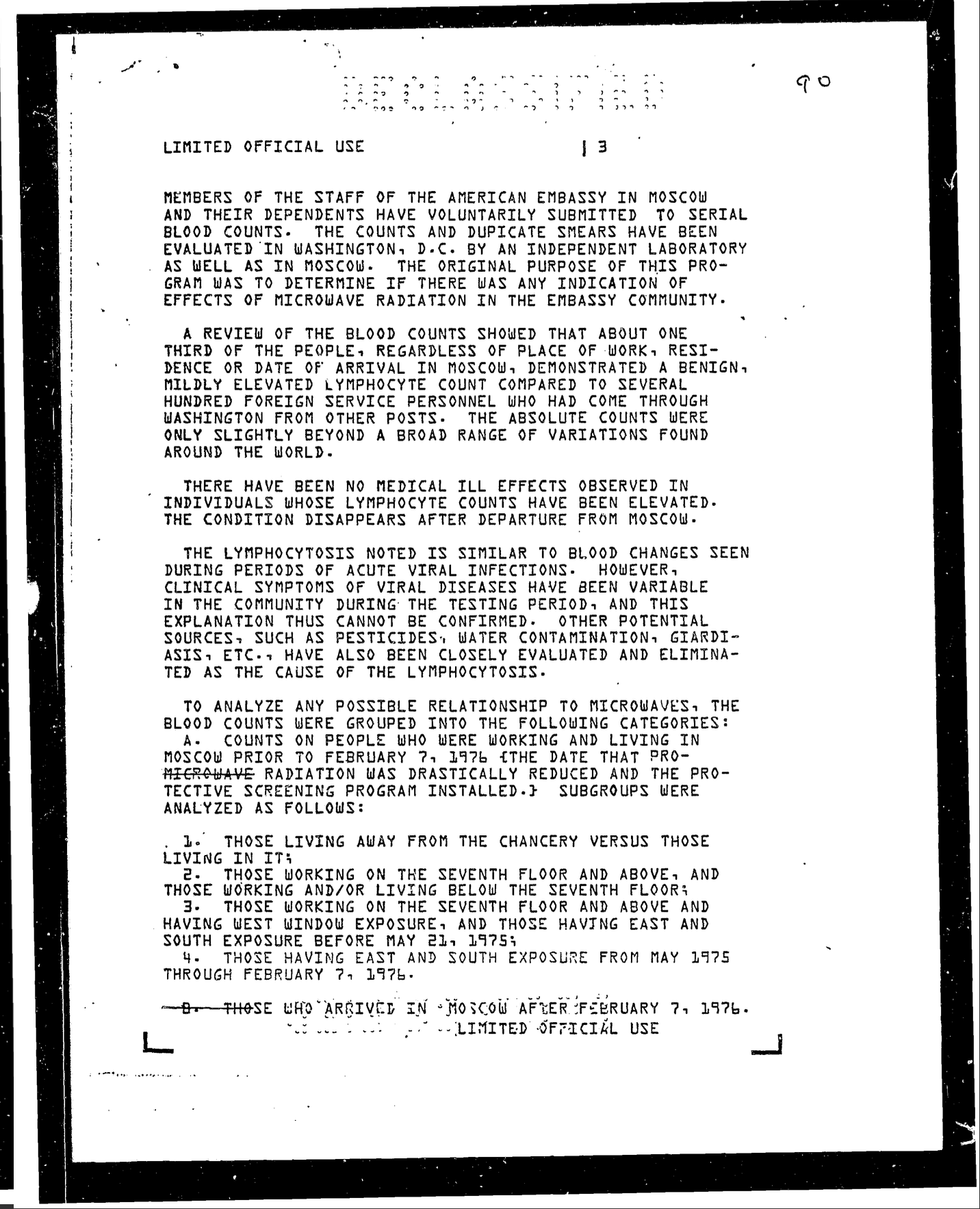

Notice confirming that one-third of American officials at the U.S. Embassy in Moscow had elevated lymphocyte count.
James Schumaker was among those stationed at the U.S. Embassy in Moscow. He arrived in the summer of 1977 to work as a staff aide to Ambassador Toon, who had replaced Ambassador Stoessel. He was aware of what had been happening at the embassy regarding microwave radiation, but as a junior staffer, he was much more concerned about learning how to do his job right.
“We knew who was doing it. We knew it was the Soviets,” James told Whale Hunting. “But what we didn’t know was if there were medical effects involved,” he added.
It wasn’t only after James returned to the U.S. that he found out he had a high white cell count.
“They said, 'well, you've got a high white count, but don't worry, that's not unusual for Moscow,'” James recalled.
In 1985, James was diagnosed with Chronic Lymphocytic Leukemia.
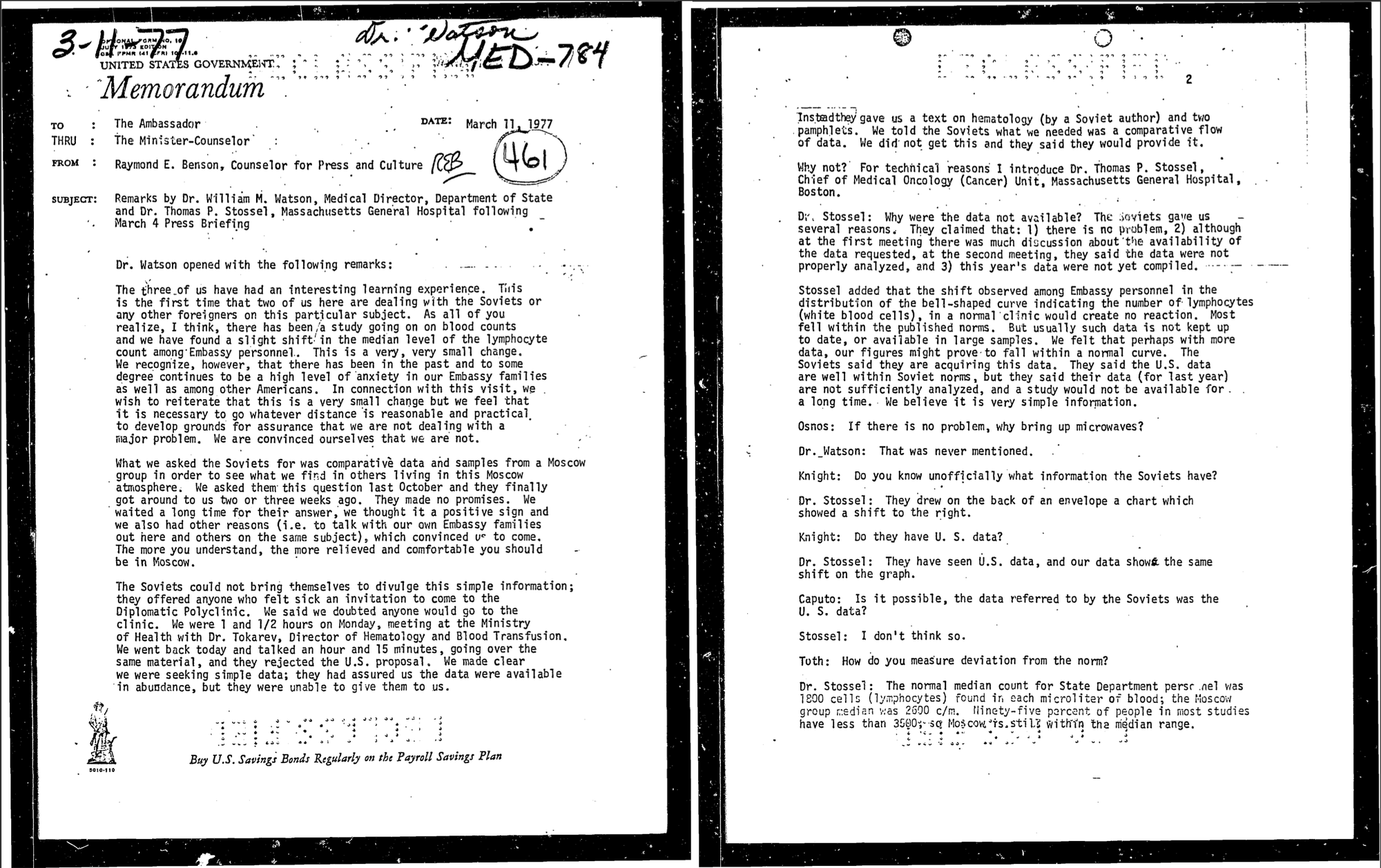
But the Moscow Signal is only half the story. The other half is what Soviet scientists were doing in parallel: systematically documenting the biological effects of microwave exposure on humans.
From the 1950s onward, the Soviet Union undertook extensive biomedical research into the effects of radio-frequency and microwave radiation on living organisms. This wasn't academic curiosity—it was motivated by military, space, and intelligence interests. By the late 1960s, Soviet military medical practitioners had identified a distinct clinical syndrome associated with chronic microwave exposure.
They called it "радиоволновая болезнь" (radiowave sickness).
The symptoms they documented included:
Read that list again. Then compare it to the symptoms reported by Havana Syndrome victims: headaches, dizziness, cognitive impairment, sleep disturbances, neurological damage.
They're identical.
Soviet researchers weren't just exposing Americans to microwave radiation in Moscow—they were simultaneously documenting, in clinical detail, exactly what would happen to people exposed to these frequencies. They knew. They wrote it down. They published it in medical journals.
A 1968 monograph written by a Moscow biophysicist Aleksandr Samuilovich Presman titled Electromagnetic Fields and Life synthesized Soviet research and legitimized bioelectromagnetics as a field. Soviet experiments on animals and human subjects examined non-thermal effects of microwaves—nervous system and cardiovascular changes that occurred below heating thresholds.
A 1978 paper titled Special Characteristics of the Interaction of Electromagnetic Fields with Biological Entities, authored by Russian scientists, noted that “the problem of the biological effects of radio-frequency electromagnetic fields has become particularly urgent in recent years” due to the growing use of radio communications, radar, and television. The authors warned that while microwave-emitting devices have clear practical benefits, “when used without proper control, they create extremely high levels of radiation and can be hazardous to human health.”
Russian researchers were also studying how certain weapons could be used to influence human behavior—shaping public opinion, altering mental states, and even affecting consciousness.
In a 2017 paper written by Russian Doctor of Chemistry Sergey Makarenko, Information Confrontation and Electronic Warfare in Network-Centric Warfare at the Beginning of the 21st Century, he compiles Russian research on how weapons can be key to achieving goals in modern warfare.
Makarenko talks about psychotronic weapons, which refer to man-made technologies designed to influence or control a person’s physical state, psyche, and consciousness from a distance. These include electromagnetic, infrasound, ultrasound, laser, and light-based devices. Research cited by Russian sources indicates that prolonged exposure to microwave and ultra-high frequency radiation can induce physiological stress responses, genetic changes, and immune suppression.
The United States had long been aware of Russia’s deep involvement in this line of research. A classified 1976 Defense Intelligence Agency report titled Biological Effects of Electromagnetic Radiation - Eurasian Communist Countries warned that "Eurasian Communist countries are actively involved in evaluation of the biological significance of radiowaves and microwaves." The report specifically notes research into effects on the "central nervous system" and "internal sound perception"—precisely the symptoms that would emerge in Havana four decades later.
Below are fragments of the paper:
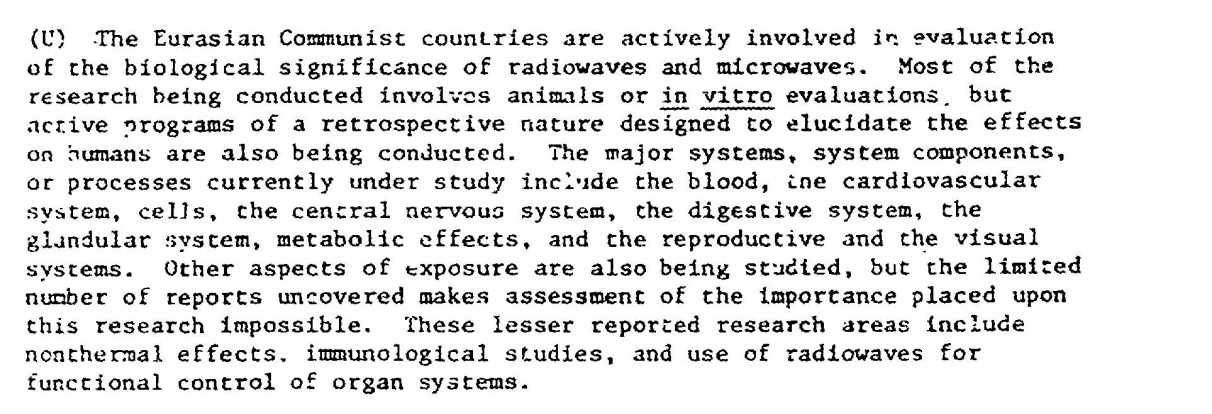
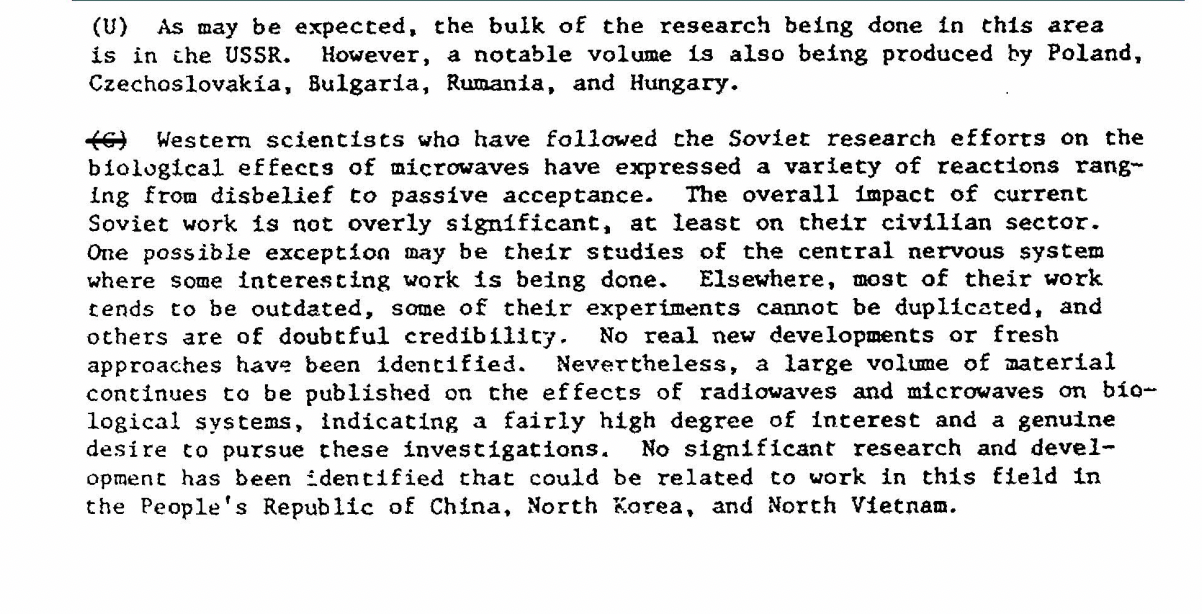
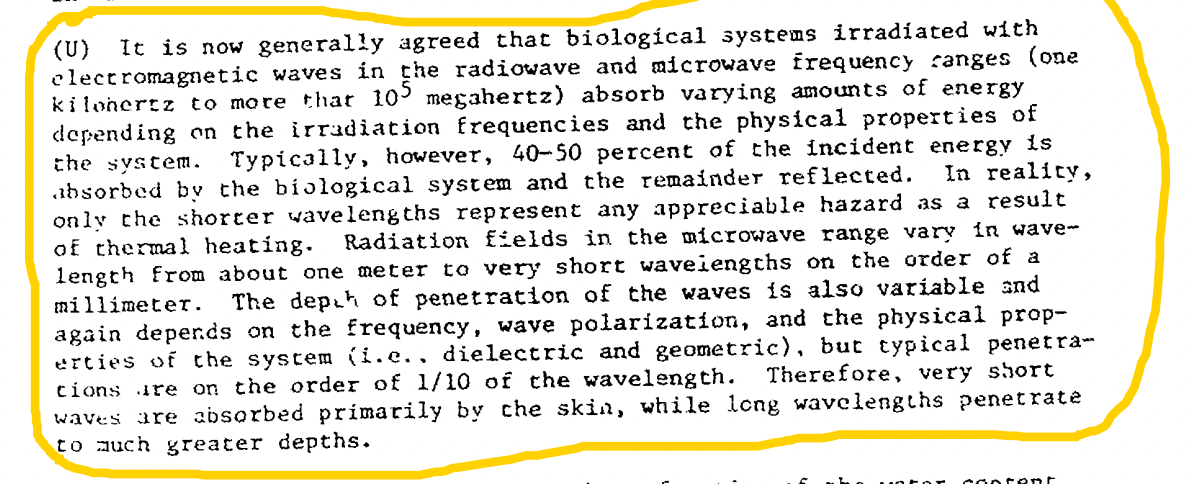
While Soviet biomedical researchers were documenting radiowave sickness, Soviet physicists were working on weaponization.
Research at the Lebedev Physical Institute's Plasma Laboratory, led by physicist M.S. Rabinovich, demonstrated the feasibility of accelerating plasma with powerful microwaves and generating intense beams. The goal was a directed-energy weapon capable of disabling satellites or missiles at great distances—potentially 100 kilometers away.
The program injected enormous funding into Soviet directed-energy research, creating a technical lineage that would persist through the collapse of the USSR and into modern Russia. While the exact outcomes remain classified, the institutional knowledge and expertise developed in this program formed the foundation for later systems.
After the Soviet Union collapsed, Russia's microwave weapons program experienced both setbacks and continuities. The 1990s saw the emergence of the Ranets-E mobile high-power microwave defense system, developed by the Moscow Radiotechnical Institute. Publicly unveiled at the 2001 LIMA arms exhibition in Malaysia, Ranets-E was mounted on a MAZ-543 heavy truck and featured a large parabolic antenna.

The system's specifications were formidable: peak output power of approximately 500 megawatts, emitting nanosecond microwave pulses in the centimeter wavelength band, with a guaranteed electronics kill range of 10-14 kilometers and disruptive effects out to 40 kilometers.
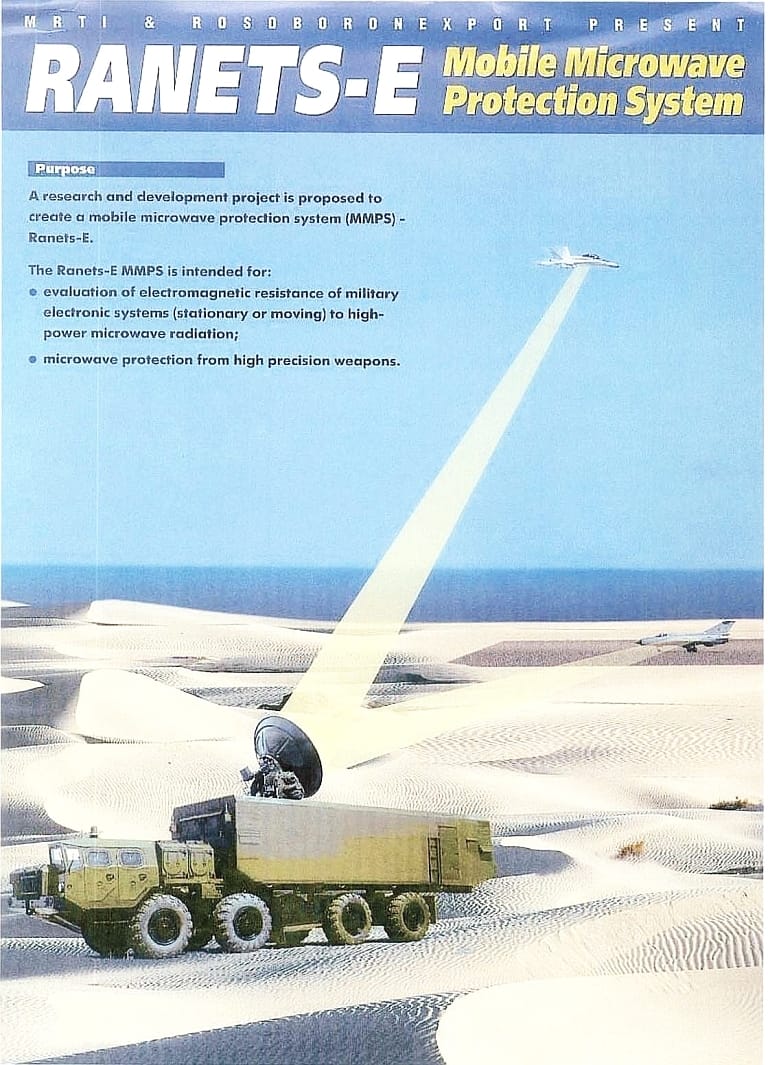
Despite demonstrating viability, Ranets-E was ultimately not adopted for service due to operational limitations: line-of-sight requirements, slow recharge cycles, and vulnerability to standoff tactics. But the technology didn't disappear—it evolved.
In the 2010s, Russia developed an electromagnetic system called Albuga, which involves missile-delivered electromagnetic pulse warheads. These warheads, detonating at altitudes of 200-300 meters, reportedly produce localized EMP effects with a radius of approximately 3.5 kilometers—sufficient to incapacitate all unshielded electronics within the area without nuclear fallout.
Russia has also operationalized portable electromagnetic weapons, particularly for countering drones. Systems like Stupor (developed by the Ministry of Defense's Main Robotics Research Center) and Harpun-3 (produced by private firms) are lightweight, shoulder-fired electromagnetic guns capable of jamming drone control links at ranges up to two kilometers.


After examining seven decades of microwave weapons development by the world's two most capable adversaries, we're left with a troubling conclusion: both Russia and China possess the technical capability to conduct Havana Syndrome attacks. But the evidence doesn't weigh equally.
China has superior technology. Their gigawatt-class HPM systems represent the cutting edge of directed-energy weapons development. The 2010 breakthrough, the Hurricane systems, the sustained institutional commitment—all point to a program that has achieved what the United States is still working toward. And the Guangzhou incidents, where Mark Lenzi and his family were attacked, occurred on Chinese soil with the technical sophistication that matches Chinese capabilities.
But Russia has the operational history. The Moscow Signal wasn't a one-time experiment—it was a 23-year operation targeting Americans with directed microwave energy. Soviet researchers didn't just build weapons; they documented the medical effects in clinical detail, creating a playbook for what would become Havana Syndrome. And Russia's intelligence services have the global reach, operational tradecraft, and strategic motive to conduct covert attacks on American personnel worldwide.
Attorney Mark Zaid, who represents two dozen Havana Syndrome victims, notes that "the vast majority" of his FBI-afflicted clients were doing something related to Russia at the time of their attacks.
This isn't a coincidence.
Does that mean China is innocent? Not necessarily. The technical sophistication of some attacks, particularly in Asia, suggests capabilities that might exceed Russia's current systems. It's possible that both nations have conducted attacks, or that technology transfer has occurred between them. The Russia-China strategic partnership includes military cooperation, and directed-energy weapons would be a natural area for collaboration.
But if we're forced to choose the most likely perpetrator based on available evidence, the answer is Russia. The Moscow Signal is the smoking gun—not just proof of capability, but proof of intent, operational experience, and documented knowledge of the biological effects. They've done it before. They wrote the medical textbook on what happens. And they're doing it again.
The investigation into Havana Syndrome continues, but it's increasingly clear that we're not looking for an unknown weapon or mysterious phenomenon. We're looking for a known capability, deployed by a known adversary, using techniques that were documented decades ago.
The challenge isn't figuring out if it's possible—we know it is. The challenge is attribution: catching the perpetrator in the act, gathering forensic evidence, and building a case strong enough to justify a response. Because if Russia (or China, or both) is conducting covert attacks on American personnel using directed-energy weapons, that's not just a security threat—it's an act of war.
The hunt continues.
Coming Soon: We examine the U.S. government's response to Havana Syndrome—from the initial cover-up to the ongoing battle for recognition and care. Why did agencies use faulty equipment? Why were victims sent to psychiatrists instead of doctors? And what does the government know that it's not telling us?
Join the investigation: If you have information about Havana Syndrome incidents, directed-energy weapons programs, or government responses, contact us securely at syndrome@projectbrazen.com.




Check out the Brazen Whale Hunting Collection.
Got a question or a tip for us? Get in touch at whalehunting@projectbrazen.com. You can also contact us securely here.
You can also follow Whale Hunting on Instagram, Threads and on X (Twitter). To chat with fellow Whale Hunters and stay in touch with Bradley and Tom, join our Discord server.
For unlimited access to Whale Hunting’s investigative reporting, consider signing up for a paid subscription. You’ll get special editions of the newsletter and the Weekender, as well as premium podcast access and discounted merch.
Enjoying Whale Hunting but not ready to subscribe? Show your support by leaving a tip (via credit/debit card or crypto) instead.
 Related Posts
Related Posts